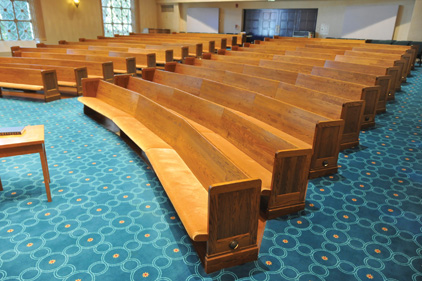Ah, those rules. Safety has its commandments, its cardinal rules. Just about any company can dust off its safety rulebook. Cite its safety doctrine. OSHA regs are chock full of “shall” and “shall not” exhortations. Has anyone called OSHA “dogmatic” lately? I think I see a hand go up somewhere.
Both religion and safety lean on rules because both are trying in effect to perfect what is imperfect – human beings. More to the point, both focus on behaviors. Consider the Ten Commandments: don’t steal, don’t kill, don’t commit adultery, don’t covet other’s possessions, don’t honor false idols, honor thy father and mother, chill out on Sundays, etc. These are mostly “at-risk” behaviors you want to avoid if you want to pass through the pearly gates.
In safety, if you don’t want to climb the stairway to heaven before your time, you’ll follow lockout-tagout procedures, confined space entry procedures, wear your PPE, know your hazardous substances, avoid distracted driving, and work safely at heights and in trenches, among many other things.
Perfection is an idealized notion in both religion and safety. Seldom is perfect behavior, a perfect zero incident safety scorecard, or perfect earthly human performance achieved. What both religion and safety emphasize is the journey, the path to perfection. Both ask for a personal commitment to the journey. Both say it is a holistic, life-long, 24/7/365 commitment.
Required soft skills
For individuals on the path, both religion and safety require “soft skills” (self-direction, self-responsibility, accountability, being your brother’s keeper, caring and sharing, and being firm in one’s convictions). Convictions and beliefs are indispensable to staying on the path. A bit of passion never hurts.
One useful tool employed by both religion and safety is mindfulness. Being mindful of what you are doing in the moment. To stay injury-free, it’s important to be “in the moment.” You can also call it safety awareness, situational awareness, being safety conscious.
You can be mindful, you can be a true believer, but neither religion nor safety will guarantee a predictable, danger-free world. Random events happen, even to the closest adherents of the “faith.” The result in both cases is confusion and inner conflict and doubt. “Geez, if a safety-conscious guy like George gets hurt, why bother? Where’s the protection?”
“He was a God-fearing, church-going man. Didn’t smoke. Didn’t drink. How is it he got hit by a drunk driver?”
Disappointments and apparent contradictions will cause some to drop out of the company of the committed. Every workplace has its safety atheists. Non-believers. Non-participants. Most are not active resistors; like non-churchgoers, they just want to be left alone. “Don’t try to sell me. Or convert me.”
Engaging the “congregation”
Both religion and safety face a similar challenge in 2013: how to hold the flock together. Both church and safety leaders are embroiled in trying to engage the congregation, the workforce. People lead hectic lives. Many hold down two jobs to make ends meet. Children and their travel sports teams and endless after-school activities demand time and attention. So do aging parents who need care. These realities put a strain on finding volunteers, at church and at work. Engaging and connecting, and increasing participation, require fresh thinking and innovative programs – both in a church and a workplace.
Safety and the church face a test of leadership today. The crisis is more evident in religion. Numbers from actual counts of people in Orthodox Christian churches (Catholic, mainline and evangelical) show that in 2004, 17.7 percent of the population attended a Christian church on any given weekend.
What percent of your workforce actively participates on a regular basis in safety activities? I wouldn’t be surprised if the number was around 17 to 20 percent.
The same social factors press in on religion and safety: At a time when human interaction is being supplanted by everything virtual, many younger people entering the “real world” after schooling are looking for something that offers community, maybe some fun and entertainment, and perhaps intergenerational mentoring. They possess a desire for belongingness.
There is an opportunity here. Why not use a safety program (can you think of a better workplace welcoming platform?) and certainly a church, to supply the relevancy and connectivity folks are seeking. There is a danger, too. Many companies still hold on to yesterday’s command and comply safety doctrine and attempt to “modify behaviors.” Not an engaging approach. Many mainstream churches remain bound to tradition, and watch membership rolls shrink with age.
Signs of decline
The attributes of a church in decline cited by experts are eerily similar to a faltering safety program: 1) lack of mission and vision clarity; 2) failure to define a strategy to help newcomers become engaged; 3) complex structure; 4) inward-focused with little connection to the larger community; 5) weak leadership.
There are other parallels. Leaders dig their heels into the traditions that got them where they are today. They go back to what is comfortable. They refuse to try anything new. They quit taking risks.
In the next five to ten years, a flood of young employees will enter the workplace, replacing retiring baby boomers. Safety leaders will be tested to engage these new employees and get them to “see the light” regarding safety’s practical benefits, and its ability to increase self-esteem and build those soft skills such as emotional intelligence.
Just as with church leaders, safety leaders want “the congregation” to rarely experience boredom or frustration during meetings and activities. Those new to a church or a safety program will want to participate in decision-making and provide input. Safety and the church will have to try new ways to create and sustain a sense of belonging.
Energy and momentum will help safety and religion connect and engage. So will projecting excitement and optimism about the future. Individuals are more likely to commit to a clear, make-a-difference vision and relevant directions. Openness, trust, empathic leadership and a willingness to always try something new will sustain their journey.




